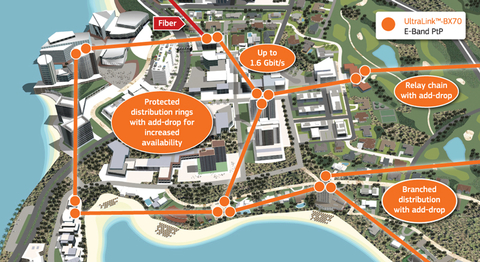Despite the progress made in broadband access connectivity in the last decade, there is a large number of cases where access connectivity of the right capacity and price is not available at the SME location, creating difficulties for their operations and degrading business efficiency. The problem is prevalent in areas where optical fiber is hard to reach and/or the deployment of optical fiber up to the enterprise premises is not financially justifiable. SMEs are keen to select a service package from a service provider, incumbent or competitive, who needs to be able to deliver reliable connectivity for business-critical services at the right price, deploy these services quickly and manage the service SLAs effectively.
Options and challenges for the delivery of SME services
................................................................................................
Operators or access network service providers have a number of options for the enhancement of their network in order to deliver enhanced level broadband access and connectivity to SMEs and/or larger enterprises. Fiber has come closer to the final user, usually up to the street cabinet and in some cases up to the user premises. Ever more advanced xDSL standards have been implemented on the traditional installed base of access copper to bridge the final few hundreds of meters from the fiber connected distribution cabinet to the user premises. In some countries CATV Hybrid– Fiber Coax networks have been adapted, via DOCSIS technologies, to deliver Internet services along with TV content. Even so there is a large number of cases where the revamped copper cannot deliver the service quality and capacity needed. Furthermore, installing fiber up to the user premises is too expensive and slow. Enhancing the access networks to support high-speed Internet services is challenging from a technological and economic perspective. Access network service providers are faced with a number of challenges, especially in cases where there is no state-funded support for the development of access networks:
• Lowering TCO to enable market viable service pricing levels.
• Upgrading the network in parallel to the growth of demand for services and avoiding extensive up-front investment.
• Setting up the network and activating services quickly and effectively.
Today, service providers delivering services to SMEs can employ a new generation of wireless systems to quickly and cost effectively set up reliable, high capacity networks that fully serve their needs.
Introducing E-Band technology to access networks
................................................................................................
Intracom Telecom, acknowledging the existence of a market segment with particular need for a radio system with comparable performance to optical fiber at a price point that can better support the access connectivity business model, has designed and developed the UltraLink™-BX70 E-Band radio. E-Band radio technology exploits frequencies in the 71-86 GHz range, to implement wireless point-to-point links accommodating 1 Gbps+ capacity at ranges of several kilometers. The E-Band spectrum is treated favorably by the majority of regulators around the world in terms of licensing cost and complexity, enabling low recurring licensing costs.
UltraLink™-BX70, an ultra-compact all outdoor Ethernet radio operating in the 71-76 GHz part of the E-Band spectrum, is ideally suited for use in cost-sensitive, high capacity applications. Operating in TDD mode, it can offer flexibility and efficiency in the delivery of services with asymmetric traffic profiles, such as broadband access or camera backhaul services. It achieves throughputs of up to 1.6 Gbit/s aggregate, while offering a complete set of Carrier Ethernet networking features to deliver standardized SLA-enabled services. UltraLink™-BX70’s small size enables convenience and speed of installation in traditional telco, as well as, street-level environments. Furthermore, it offers operational simplicity by exploiting the automations enabled by Intracom Telecom’s NMS, uni|MS™, SON Manager, which minimizes rollout time and cost, safeguards against deployment errors and simplifies monitoring and maintenance, especially for large scale deployments.
The UltraLink™-BX70 radio unit features two Gigabit Ethernet ports and an embedded Ethernet Bridge enabling deployment flexibility in complex network topologies, such as branched access distribution networks and protected ring topologies with add-drop functionality. Many times SMEs rely on the network for the delivery of business-critical services therefore requiring higher availability connectivity. UltraLink™-BX70 can support very high service availability by being deployed in ring configuration with super-fast protection by G.8032 ERP standard protocol.
Figure below demonstrates an example of the deployment modes of UltraLink™-BX70 for the delivery of connectivity in the context of the access network. It ideally suits applications such as last-mile delivery of wireless GTTX services, delivery of Gbit/s services to SMEs and even larger enterprises or Multi-Dwelling Units (MDUs), connectivity for government / public service buildings, utilities and industrial complexes, university campus building interconnection, security camera and Wi-Fi access point backhaul.
